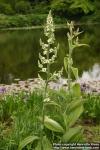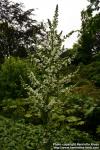Veratrum Album.—White Hellebore.

 Preparations: Ointment of White Hellebore
Preparations: Ointment of White Hellebore
Related entries: Veratrum Viride (U. S. P.)—Veratrum Viride
- Veratrina.—Veratrine
- Sabadilla.—Cevadilla
- Helleborus.—Black Hellebore
The rhizome and rootlets of Veratrum album, Linné.
Nat. Ord.—Liliaceae (Melanthaceae).
COMMON NAME AND SYNONYMS: White veratrum; Rhizoma veratri, Radix hellebori albi.
ILLUSTRATION: Bentley and Trimen, Med. Plants, 285.
Botanical Source.—Veratrum album is a perennial herb, with a fleshy, oblong, somewhat horizontal, premorse rhizome, about the thickness of a finger, blackish or brownish-white externally, whitish or pale yellowish-white internally, having numerous fleshy, brownish-white fibers or true roots. The stem is straight, round, striated, and from 1 to 4 feet high. The leaves are alternate, plaited, broad-ovate, and acutish. The flowers are yellowish-white, green at the back, 8 lines in diameter, and produced in a terminal panicle; segments spreading, serrulate, and somewhat wavy. In other respects it resembles the Veratrum viride. (L.).
 History and Description.—White hellebore inhabits Europe, especially the Alpine and Pyreneean districts. Under the name Veratrum californicum, Durand, this plant is said to have been found in Colorado and other western states. The part used is the rhizome, though the whole plant is highly noxious. The dried root, as it occurs in pharmacy, consists of a single, double, or many-headed rhizome, cylindrical, or in the form of a truncated cone, from 2 to 4 inches by 1 inch, rough, corrugated, grayish or blackish-brown externally, having a faint, unpleasant odor, and a sweetish, bitter, and then intensely disagreeable, and permanently acrid taste. Diluted alcohol is its best solvent. Its powder is somewhat of an ash color.
History and Description.—White hellebore inhabits Europe, especially the Alpine and Pyreneean districts. Under the name Veratrum californicum, Durand, this plant is said to have been found in Colorado and other western states. The part used is the rhizome, though the whole plant is highly noxious. The dried root, as it occurs in pharmacy, consists of a single, double, or many-headed rhizome, cylindrical, or in the form of a truncated cone, from 2 to 4 inches by 1 inch, rough, corrugated, grayish or blackish-brown externally, having a faint, unpleasant odor, and a sweetish, bitter, and then intensely disagreeable, and permanently acrid taste. Diluted alcohol is its best solvent. Its powder is somewhat of an ash color.
Chemical Composition.—Much confusion as to the active principles of the root of white hellebore, existed prior to the researches of Wright and Luff (Jour. Chem. Soc., 1878, pp. 338-359, and 1879, pp. 405-426; also see Amer. Jour. Pharm., 1878, p. 489, and 1879, p. 367). Contrary to previous statements by Pelletier and Caventou (1819), Weigand (1842), Weppen (1873), and, in accordance with the views of Dragendorff (1872) and Tobien (1877), these authors established the absence of cevadine, the active principle of sabadilla seed (see Veratrina and Veratrum Viride). They believe the poisonous properties of white hellebore to be due to an amorphous alkaloid, veratralbine (C26H43NO5). In addition, the authors found three crystallizable alkaloids, jervine (C26H37NO3), discovered by E. Simon, in 1837, and called by him barytine, because, like barium salts, it formed an almost insoluble sulphate; pseudo-jervine (C29H43NO7); and rubijervive (C26H43NO3).
The painstaking researches of G. Salzberger (Archiv der Pharm., 1890, pp. 462-483) have thrown further light on this subject. The author discovered a crystallizable base (protoveratrine, C32H51NO11) of enormous poisonous activity, and extremely sensitive to alkalies. It is permanent in the air., insoluble in water, benzol, petroleum ether, quite soluble in chloroform, and in boiling (96 per cent) alcohol, little soluble in cold ether, easily soluble in dilute acids, except acetic acid. Its alcoholic solution turns red litmus paper blue, and a trace of its powder excites violent sneezing. The crystals dissolve in concentrated sulphuric acid with greenish color, which turns blue, and, later, violet. Warming with concentrated sulphuric acid produces vapors of isobutyric acid, and the liquid turns dark cherry-red. About 0.03 per cent was obtained from the root. In addition, the author found the following crystallizable alkaloids, all being nearly insoluble in ether, and indications of other alkaloids existing in the root: Protoveratridine (C26H45NO8), 0.005 per cent, almost insoluble in alcohol and ether, physiologically inert, and probably a decomposition product of protoveratrine; jervine (0.1 per cent crude alkaloid), pseudo-jervine, and rubijervive (0.005 per cent), which he found of the composition and the general properties assigned to them by Wright and Luff. Jervine is feebly toxic, and is the most abundant of the veratrum alkaloids. Its salts, with sulphuric, hydrochloric, and nitric acids are very little soluble in water. The two other bases are physiologically inert. Wright and Luff's veratralbin is considered by Salzberger as not sufficiently characterized chemically. The root also contains a green, fatty oil and a volatile oil of a delicious and permanent anise flavor.
Action, Medical Uses, and Dosage.—White hellebore is a violent irritant poison, occasioning, when snuffed up into the nostrils, severe coryza. When swallowed, it causes sore mouth, swelling of the tongue, gastric beat, and burning, severe vomiting, and often profuse diarrhoea. Vertigo, weakness, and tremors of the extremities, feeble pulse, loss of voice, dilatation of pupils, spasms of the ocular muscles, blindness, cold sweating, and mental disturbances are also produced. When it proves fatal, narcotic symptoms are superadded, such as prolonged stupor and convulsions. Gastro-intestinal inflammation has also been produced by it. When not fatal, distressing praecordial oppression persists for some time, and there are produced nervous and spasmodic symptoms and prolonged debility. It was formerly administered as an emetic and purgative in insanity, as a diaphoretic in some diseases of the skin, and as a sternutatory, in combination with some other powder to modify its action, in headache, amaurosis, and ophthalmia. Poisoning by white hellebore may be treated by coffee as a drink and in injection, with stimulants to overcome the depressed condition of the heart and arteries, and opiates and demulcents to relieve internal inflammation. At present it is rarely used, except in the form of decoction or ointment, as an external application to kill lice, and cure the itch, pruritis, and some other cutaneous affections; but, used thus, it is not always free from danger. It has been used for the cure of gout, as a substitute for the Eau Médicinale of Husson; 3 parts of the wine of white hellebore added to 1 part of laudanum, was given in doses of from ½ to 2 fluid drachms. Minute doses of a tincture of Veratrum album are efficient in bowel disorders, with gushing, watery evacuations, there being more or less cramp-like or spasmodic action in the muscular ½ of the intestines and abdominal walls. It has thus been employed in cholera infantum, cholera morbus, in both of which it also cheeks the vomiting, and in Asiatic cholera. For these uses the 3 x dilution may be added to water in the proportion of 30 drops of the tincture to 4 fluid ounces of water, the dose of which, in severe cases, is a teaspoonful every 15 minutes. For its earlier uses, the dose of the powder is from 1 to 8 grains, gradually and cautiously increased, commencing with 1 grain; of the vinous tincture, from 20 to 60 minims. Its use always requires great care.
Specific Indications and Uses.—Gushing watery discharges from the bowels, with spasmodic or cramp-like action of the intestines and abdominal parieties; cold face; sunken eyes; body covered with cold sweat.
Related Species.—Veratrum album var. Lobelianum, Bernhardt (Veratrum album var. viridiflorum of Mertens and Koch), is a European plant closely related to white and American hellebore. Its chief difference consists in its having bracts of a greater length, and a simpler inflorescence, the blossoms of which are pale-green. Tobien (1877) found jervine and veratroidine in both the rhizome and young leaves of this species.

